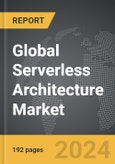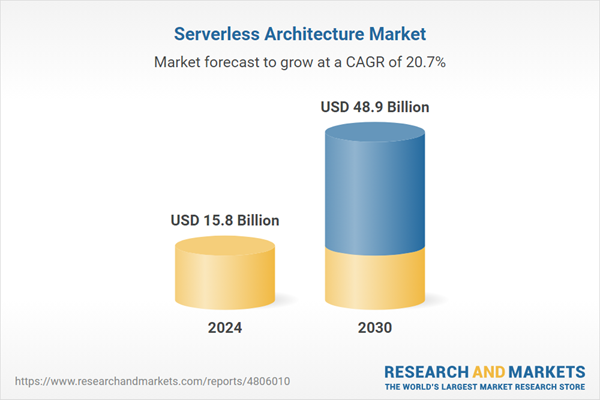The global market for Serverless Architecture was valued at US$15.8 Billion in 2024 and is projected to reach US$48.9 Billion by 2030, growing at a CAGR of 20.7% from 2024 to 2030. This comprehensive report provides an in-depth analysis of market trends, drivers, and forecasts, helping you make informed business decisions. The report includes the most recent global tariff developments and how they impact the Serverless Architecture market.
Segments: Type (Automation & Integration, Security, Monitoring & API Management, Support & Maintenance, Training & Consulting, Other Types); Deployment (Public Cloud, Private Cloud, Hybrid Cloud).
Geographic Regions/Countries: World; United States; Canada; Japan; China; Europe (France; Germany; Italy; United Kingdom; and Rest of Europe); Asia-Pacific; Rest of World.
The analysts continuously track trade developments worldwide, drawing insights from leading global economists and over 200 industry and policy institutions, including think tanks, trade organizations, and national economic advisory bodies. This intelligence is integrated into forecasting models to provide timely, data-driven analysis of emerging risks and opportunities.
Global Serverless Architecture Market - Key Trends and Drivers Summarized
Why Is Serverless Architecture Gaining Traction Among Developers?
Serverless architecture is gaining significant traction among developers and organizations due to its ability to simplify application deployment, reduce operational costs, and enhance scalability. Unlike traditional server-based models, serverless architecture allows developers to focus on writing code without worrying about server management, scaling, or infrastructure maintenance. Function-as-a-Service (FaaS) platforms, such as AWS Lambda, Microsoft Azure Functions, and Google Cloud Functions, are driving the adoption of serverless architecture by providing a pay-as-you-go model where users are charged only for the actual compute time consumed. The growing need for rapid application development, continuous integration/continuous deployment (CI/CD), and microservices architecture is further fueling the demand for serverless solutions in cloud-native environments.How Are Technological Advancements Influencing Serverless Computing?
Technological advancements are significantly influencing serverless computing, making it more powerful, secure, and versatile. The integration of AI and machine learning with serverless platforms is enabling real-time data processing, event-driven computing, and automated scaling, which are critical for dynamic applications and workloads. The development of multi-cloud and hybrid serverless architectures is allowing organizations to leverage the benefits of serverless across different cloud environments while avoiding vendor lock-in. Innovations in containerization, API management, and Backend-as-a-Service (BaaS) are enhancing the flexibility and functionality of serverless applications, enabling seamless integration with existing IT ecosystems. Moreover, the focus on improving cold start latency, enhancing security, and providing better observability and monitoring tools is making serverless architecture more robust and reliable for enterprise-grade applications.Which Market Segments Are Leading the Adoption of Serverless Architecture?
The serverless architecture market is segmented by service model, deployment mode, application, end-user, and region. Service models include Function-as-a-Service (FaaS) and Backend-as-a-Service (BaaS), with FaaS being the most widely adopted due to its ability to execute discrete functions in response to events. Deployment modes cover public cloud, private cloud, and hybrid cloud, with public cloud being the dominant segment due to the extensive offerings from major cloud providers. Applications of serverless architecture span web and mobile backend development, IoT backend, real-time data processing, API management, and DevOps automation, with web and mobile backend development being the largest segment. End-users include startups, SMEs, and large enterprises, with startups and SMEs leading the market due to their need for cost-effective and scalable solutions. Geographically, North America and Europe are the leading markets for serverless architecture due to advanced cloud adoption and innovation ecosystems, while Asia-Pacific is emerging as a high-growth region driven by digital transformation and increasing cloud investments.What Are the Key Drivers of Growth in the Serverless Architecture Market?
The growth in the serverless architecture market is driven by several factors, including the increasing adoption of microservices, containerization, and cloud-native application development, advancements in AI and real-time data processing, and the rising demand for scalable and cost-efficient computing models. The development of multi-cloud and hybrid serverless architectures that offer flexibility, security, and integration capabilities is driving market adoption among enterprises, SMEs, and digital-native companies. The focus on reducing operational costs, enhancing developer productivity, and supporting continuous integration/continuous deployment (CI/CD) pipelines is expanding the market reach across fintech, e-commerce, and media sectors. The growing use of serverless solutions for IoT, edge computing, and API-driven services is creating new opportunities for market growth. Additionally, the increasing investments in R&D for serverless platforms with improved security, observability, and cold start performance are further supporting market expansion.Report Scope
The report analyzes the Serverless Architecture market, presented in terms of units. The analysis covers the key segments and geographic regions outlined below.Segments: Type (Automation & Integration, Security, Monitoring & API Management, Support & Maintenance, Training & Consulting, Other Types); Deployment (Public Cloud, Private Cloud, Hybrid Cloud).
Geographic Regions/Countries: World; United States; Canada; Japan; China; Europe (France; Germany; Italy; United Kingdom; and Rest of Europe); Asia-Pacific; Rest of World.
Key Insights:
- Market Growth: Understand the significant growth trajectory of the Automation & Integration segment, which is expected to reach US$16.2 Billion by 2030 with a CAGR of a 23.3%. The Security segment is also set to grow at 21.8% CAGR over the analysis period.
- Regional Analysis: Gain insights into the U.S. market, valued at $4.4 Billion in 2024, and China, forecasted to grow at an impressive 19.2% CAGR to reach $7.1 Billion by 2030. Discover growth trends in other key regions, including Japan, Canada, Germany, and the Asia-Pacific.
Why You Should Buy This Report:
- Detailed Market Analysis: Access a thorough analysis of the Global Serverless Architecture Market, covering all major geographic regions and market segments.
- Competitive Insights: Get an overview of the competitive landscape, including the market presence of major players across different geographies.
- Future Trends and Drivers: Understand the key trends and drivers shaping the future of the Global Serverless Architecture Market.
- Actionable Insights: Benefit from actionable insights that can help you identify new revenue opportunities and make strategic business decisions.
Key Questions Answered:
- How is the Global Serverless Architecture Market expected to evolve by 2030?
- What are the main drivers and restraints affecting the market?
- Which market segments will grow the most over the forecast period?
- How will market shares for different regions and segments change by 2030?
- Who are the leading players in the market, and what are their prospects?
Report Features:
- Comprehensive Market Data: Independent analysis of annual sales and market forecasts in US$ Million from 2024 to 2030.
- In-Depth Regional Analysis: Detailed insights into key markets, including the U.S., China, Japan, Canada, Europe, Asia-Pacific, Latin America, Middle East, and Africa.
- Company Profiles: Coverage of players such as Alibaba (China) Co., Ltd., Amazon Web Services, Inc., CA Technologies, Dynatrace LLC, Fiorano Software, Inc. and more.
- Complimentary Updates: Receive free report updates for one year to keep you informed of the latest market developments.
Some of the 38 companies featured in this Serverless Architecture market report include:
- Alibaba (China) Co., Ltd.
- Amazon Web Services, Inc.
- CA Technologies
- Dynatrace LLC
- Fiorano Software, Inc.
- Galactic Fog IP Inc.
- Google, Inc.
- IBM Corporation
- Iron.io
- Joyent, Inc.
- Manjrasoft Pty Ltd.
- Microsoft Corporation
- NTT DATA Corporation
- Oracle Corporation
- Rackspace
- Realm
- SixSq Sarl
- Snyk Ltd.
- Standard Library
- Syncano
- Tarams Software Technologies Pvt. Ltd.
- TIBCO Software, Inc.
- Twistlock Ltd.
Tariff Impact Analysis: Key Insights for 2025
Global tariff negotiations across 180+ countries are reshaping supply chains, costs, and competitiveness. This report reflects the latest developments as of April 2025 and incorporates forward-looking insights into the market outlook.The analysts continuously track trade developments worldwide, drawing insights from leading global economists and over 200 industry and policy institutions, including think tanks, trade organizations, and national economic advisory bodies. This intelligence is integrated into forecasting models to provide timely, data-driven analysis of emerging risks and opportunities.
What’s Included in This Edition:
- Tariff-adjusted market forecasts by region and segment
- Analysis of cost and supply chain implications by sourcing and trade exposure
- Strategic insights into geographic shifts
Buyers receive a free July 2025 update with:
- Finalized tariff impacts and new trade agreement effects
- Updated projections reflecting global sourcing and cost shifts
- Expanded country-specific coverage across the industry
Table of Contents
I. METHODOLOGYII. EXECUTIVE SUMMARY2. FOCUS ON SELECT PLAYERSIII. MARKET ANALYSISIV. COMPETITION
1. MARKET OVERVIEW
3. MARKET TRENDS & DRIVERS
4. GLOBAL MARKET PERSPECTIVE
UNITED STATES
CANADA
JAPAN
CHINA
EUROPE
FRANCE
GERMANY
ITALY
UNITED KINGDOM
REST OF EUROPE
ASIA-PACIFIC
REST OF WORLD
Companies Mentioned (Partial List)
A selection of companies mentioned in this report includes, but is not limited to:
- Alibaba (China) Co., Ltd.
- Amazon Web Services, Inc.
- CA Technologies
- Dynatrace LLC
- Fiorano Software, Inc.
- Galactic Fog IP Inc.
- Google, Inc.
- IBM Corporation
- Iron.io
- Joyent, Inc.
- Manjrasoft Pty Ltd.
- Microsoft Corporation
- NTT DATA Corporation
- Oracle Corporation
- Rackspace
- Realm
- SixSq Sarl
- Snyk Ltd.
- Standard Library
- Syncano
- Tarams Software Technologies Pvt. Ltd.
- TIBCO Software, Inc.
- Twistlock Ltd.
Table Information
| Report Attribute | Details |
|---|---|
| No. of Pages | 192 |
| Published | April 2025 |
| Forecast Period | 2024 - 2030 |
| Estimated Market Value ( USD | $ 15.8 Billion |
| Forecasted Market Value ( USD | $ 48.9 Billion |
| Compound Annual Growth Rate | 20.7% |
| Regions Covered | Global |









